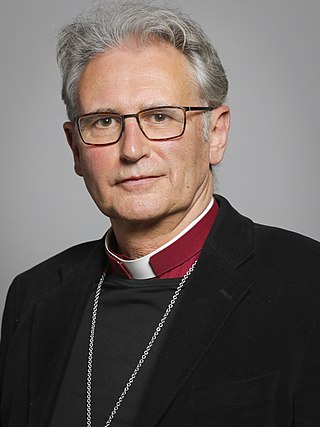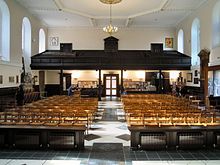
Christ Church Cathedral, more formally The Cathedral of the Holy Trinity, is the cathedral of the United Dioceses of Dublin and Glendalough and the cathedral of the ecclesiastical province of the United Provinces of Dublin and Cashel in the (Anglican) Church of Ireland. It is situated in Dublin, Ireland, and is the elder of the capital city's two medieval cathedrals, the other being St Patrick's Cathedral.

Bristol Cathedral, formally the Cathedral Church of the Holy and Undivided Trinity, is a Church of England cathedral in the city of Bristol, England. It is the seat of the Bishop of Bristol. The cathedral was originally an abbey dedicated to St Augustine, founded in 1140 and consecrated in 1148. It became the cathedral of the new diocese of Bristol in 1542, after the dissolution of the monasteries. It is a Grade I listed building.

The Cathedral Church of the Holy Spirit, Guildford, commonly known as Guildford Cathedral, is the Anglican cathedral in Guildford, Surrey, England. Earl Onslow donated the first 6 acres (2.4 ha) of land on which the cathedral stands, with Viscount Bennett, a former Prime Minister of Canada, purchasing the remaining land and donating it to the cathedral in 1947. Designed by Edward Maufe and built between 1936 and 1961, it is the seat of the Bishop of Guildford. The cathedral was listed as Grade II* by Historic England in 1981. It was the last Church of England cathedral to be consecrated on a new site, and one of only three to be built in the 20th-century, the others being Liverpool and Coventry Cathedral.

Ely Cathedral, formally the Cathedral Church of the Holy and Undivided Trinity of Ely, is an Anglican cathedral in the city of Ely, Cambridgeshire, England.

The Diocese of Peterborough forms part of the Province of Canterbury in England. Its seat is the Cathedral Church of Saint Peter, Saint Paul and Saint Andrew, which was founded as a monastery in AD 655 and re-built in its present form between 1118 and 1238.

Holy Trinity Cathedral is an Anglican cathedral situated in Parnell, a residential suburb of Auckland, New Zealand. It is the 'mother church' of the Anglican Diocese of Auckland and the seat of the Bishop of Auckland. The current main church building was consecrated in 1973.

Sutton Place, 3 miles (4.8 km) north-east of Guildford in Surrey, is a large Grade I listed Tudor prodigy house built c. 1525 by Sir Richard Weston, a courtier of Henry VIII.

Holy Trinity Church is a Church of England parish church in Westbury-on-Trym, Bristol, England.

Christopher John Cocksworth is a Church of England bishop in the open evangelical tradition who served as Bishop of Coventry from 2008 to 2023. Prior to becoming bishop, he was a university chaplain and the Principal of Ridley Hall, Cambridge (2001−2008). He took up the position of Dean of Windsor in 2023.

St Boniface Church is the mother church of the Anglican parish of Germiston, Gauteng which also includes the chapelries of St Mary and St John in Lambton, and St Mark in Rosedeep. The parish is part of the Diocese of the Highveld, which is in turn part of the Anglican Church of Southern Africa.

Sir Richard Weston (1465–1542), KB, of Sutton Place in the parish of Guildford in Surrey, was a courtier and diplomat who served as Governor of Guernsey, Treasurer of Calais and Under-Treasurer of the Exchequer during the reign of King Henry VIII.

Holy Trinity Parish Church is the parish church of Sutton Coldfield, West Midlands, England. It is Grade I listed and gives its name to the ward in which it stands, Sutton Trinity.

St Edmund's Church is the Roman Catholic parish church of Godalming, a town in the English county of Surrey. It was built in 1906 to the design of Frederick Walters and is a Grade II listed building. The church stands on a "dramatic hillside site" on the corner of Croft Road just off Flambard Way close to the centre of the town.

St Mary's Church is an Anglican church in Guildford in Surrey, England; the church's Anglo-Saxon tower is the oldest surviving structure in the town. Charles Lutwidge Dodgson, the author Lewis Carroll, preached here and his funeral was held in the church in 1898. Coming under the Diocese of Guildford, the church has been Grade I listed since 1953.






















